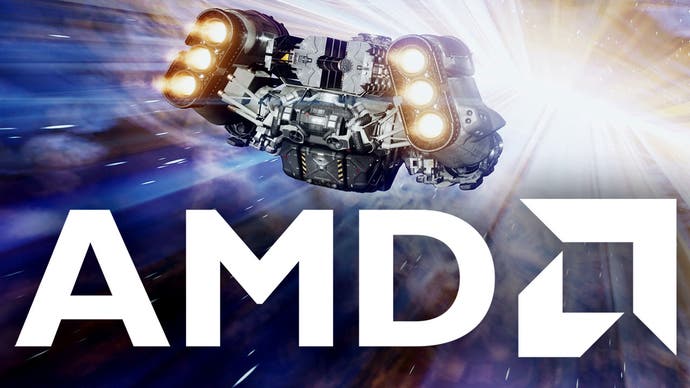DF Weekly: does the AMD Starfield deal block rival DLSS and XeSS upscaling?
AMD: 'We have no comment at this time.'
This week's DF Direct Weekly kicks off with an extensive discussion surrounding AMD's exclusive partnership with Bethesda Game Studios for Starfield. On the face of it, it's the kind of arrangement that's no different to others arranged by its competitors. In this case, AMD is BGS's exclusive tech partner and FSR2 upscaling is being integrated into Starfield in both PC and console iterations. However, there are concerns that this integration might come with a catch: qualitatively superior upscaling solutions from Nvidia and Intel - DLSS and XeSS - may be blocked from appearing in the game as part of the deal.
It's an uncomfortable possibility. Is AMD paying to ensure that Nvidia and Intel GPU owners can't use rival technologies that can look better than Radeon features? Instead of developing their own more competitive technologies, the suggestion is that AMD is using an exclusive partnership to ensure that all GPU owners only get image quality as good as that provided by an AMD graphics card. Crucially, AMD itself is not denying that it's blocking Bethesda from integrating competing upscalers into Starfield.
Let's put all of this into context. It started with an article posted on June 20th by WCCFTech, which pointed out that a great many AMD-sponsored titles are shipping with FSR2 upscaling, while the DLSS and XeSS alternatives are absent. In the case of games like Dead Island 2, The Callisto Protocol and Star Wars Jedi: Survivor, for example, the fact that they're based on Unreal Engine 4 means that DLSS and XeSS plug-ins are readily available as part of the underlying tech, but for some reason, those plug-ins are not being used.
- 00:00:00 Introduction
- 00:01:04 News 01: Starfield to skip out on DLSS, XeSS?
- 00:22:28 News 02: FTC vs Microsoft court fight continues
- 00:46:02 News 03: Red Dead Redemption remaster incoming?
- 00:52:08 News 04: Assassin’s Creed Unity gets huge performance boost on Intel Arc GPUs
- 00:57:42 News 05: New Space World 2000 footage unearthed!
- 01:08:55 Supporter Q1: If I run a 60fps game on an 85Hz CRT, will there be judder?
- 01:10:19 Supporter Q2: With the next-gen Switch rumoured to have PS4-level power, what specs would it have?
- 01:15:19 Supporter Q3: Is there something special about the Steam Deck’s refresh rate changing capabilities, or could a new Switch offer it as well?
- 01:18:31 Supporter Q4: Could a temporal upsampling system integrate high resolution keyframes to improve image quality?
- 01:21:09 Supporter Q5: Would there be space in the gaming market for a high-end $1000 PS5 Pro?
- 01:26:22 Supporter Q6: Which gaming executives would you like to see duke it out in a cage match?
Beyond UE4, AMD's FSR2 technology uses the same fundamental inputs as both DLSS and XeSS, making integration a lot simpler. That's why we've seen a range of FSR2 mods for DLSS-only games and vice-versa. We've even seen DLSS 3 frame generation modded into Star Wars Jedi: Survivor - a game that really benefits from this owing to its tremendous CPU limitations. With all of this being the case, new titles that support only one upscaler (whether it's FSR2 or DLSS) are viewed with some degree of suspicion if a sponsorship element is involved. Why is only one technology favoured? Why not provide the best quality experience for all PC owners?
In response to WCCFTech's enquiries, AMD reaffirmed its commitment to open source solutions that work on all GPUs - but at the same time, failed to deny that certain sponsorships included conditions that blocked alternative Nvidia and Intel features. Simultaneously, Nvidia confirmed that it 'does not and will not block, restrict, discourage or hinder developers from implementing competitor technologies in any way'. With that said, it is a somewhat easier policy for Nvidia to adopt owing to its market dominance overall, along with the general consensus that DLSS is qualitatively the better solution.
Even so, there was no real 'smoking gun' tying AMD sponsorship to the exclusion of competitor features - just a lot of coincidences. Based on our own enquiries over the last week, the situation is certainly more nuanced than the original WCCFTech article may suggest. We understand that one of the games in the WCCFTech list has no DLSS support because the developer has a policy of only integrating features where it has visibility on the source code, which would rule out DLSS. On the flip side, after filming this week's DF Direct Weekly, we were approached by a programmer that worked on an AMD sponsored title where his own DLSS integration work never made it into the shipping game.
Adding to the confusion is that there are AMD-sponsored games where DLSS and/or XeSS do appear, which on the face of it puts paid to the lock-out conjecture. However, it's important to stress that there is no 'one size fits all' sponsorship deal. Sometimes it's more of a marketing arrangement as opposed to a technology integration. Sometimes DLSS/XeSS may have already been integrated and there may be pushback from the developer at the idea of removing it. Regardless, clearly, there are questions to be answered by AMD and Bethesda about the Starfield arrangement. I contacted both firms last week and so far have received no reply. However, Stephen Burke from Gamers Nexus posed the question to AMD and did get a response:
Gamers Nexus: Does the contract between AMD and Bethesda have any language which intentionally blocks or could be construed as blocking or limiting Bethesda's ability to integrate alternative upscaling technologies within Starfield?
AMD: We have no comment at this time.
While still not the 'smoking gun', AMD is refusing to answer a clear and unambiguous question and as Steve Burke points out, one of two things may now happen. In a best case scenario, Starfield ships with all upscaling features and AMD can claim that the whole controversy was a nothingburger, a storm in a teacup - another classic 'jebait' scenario. Alternatively, the non-denial may be the closest to a confirmation that we're going to get that AMD's association with key titles is diminishing the quality of the experience for any RTX or Arc user looking for the best upscaling solution for their hardware - something that is definitely the case with the likes of Resident Evil 4, Star Wars Jedi: Survivor, The Callisto Protocol and Dead Island 2.
Perhaps as a result of the void of info from AMD and Bethesda, a range of arguments and possible explanations for the omission of competing upscalers have emerged since the Starfield partnership was announced. Firstly, that AMD was the obvious choice as FSR2 is the only upscaling solution that works across both consoles and all PC hardware - which is absolutely true, but should not be diminishing the options available to PC users. Secondly, there's the idea that adding those additional features has a development cost that the studio has to take on. This argument is somewhat strange as we're told that AMD itself is working with Bethesda to integrate FSR2, but both Nvidia and Intel also have engineers available to work directly with game makers, especially those making what's likely to be the biggest release of the year.
What's especially baffling about the whole scenario is that the massive wave of negative feedback heading AMD's way in the wake of this announcement isn't making PC users think positively about the Radeon brand or its association with key games. When DLSS mods appear for the likes of Resident Evil 4 that show clear image quality improvements over the FSR2 implementation that officially shipped with the game, it reflects badly on AMD and the developer/publisher associated with the deal.
It's a lose-lose scenario and ultimately, a self-defeating policy. The way forward is obvious: AMD has to produce better, more competitive products rather than including clauses in sponsorship contracts that block rival technologies, assuming that is what's happening here. And to be clear, the idea that sponsorship deals should not lock out alternative, established features needs to be applied evenly to all manufacturers - something that should go without saying.
What is the way forward in the Starfield situation? At this point, it's reputationally harmful for AMD and Bethesda to continue to withhold comment. Bearing in mind the scrutiny surrounding Starfield in general and this deal in particular, it's probably for the best to come clean on the nature of the partnership - and if there are good reasons not to integrate competing upscaling technologies, let's hear them. And in general, a greater degree of disclosure should be forthcoming on any sponsorship deal where controversies arise, whether it's with AMD, Nvidia or Intel.
The PC platform stands apart from the consoles in so many positive ways - but for me, the idea is that it's the best way to play games with the greatest degree of user choice. That choice includes buying into features and technologies that elevate the PC gaming experience beyond consoles. Nvidia's investment in AI upscaling and ray tracing is obvious across a range of titles, but these features should never come at the expense of perfectly valid alternatives if they're there. Let's hope for more clarity and an agreeable resolution to this troubling situation - and that lessons are learned going forward.

















